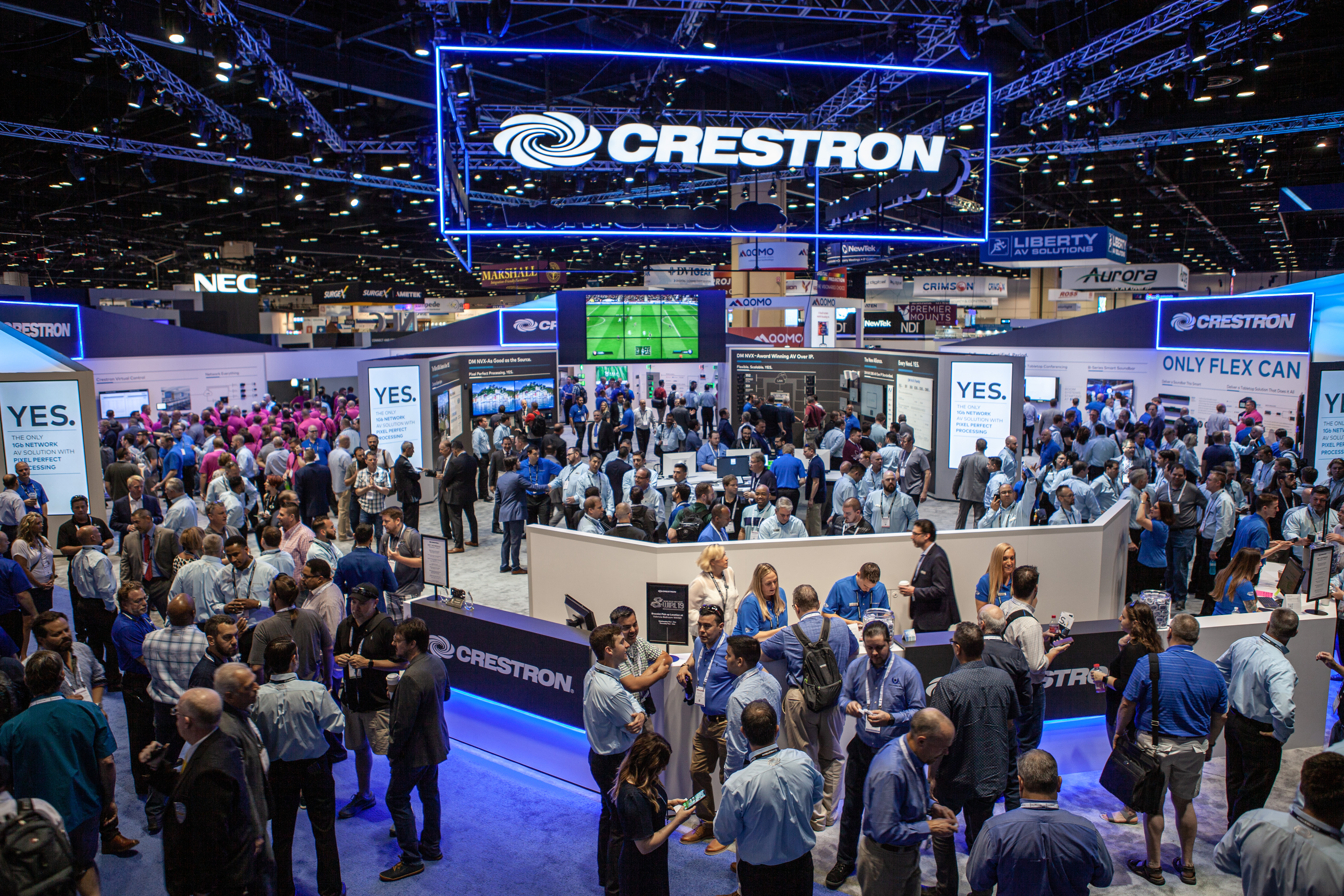To many AV companies, InfoComm represents a launch pad for new products. To Crestron, the 2019 show was something much bigger: a major step toward the realization of a new industry.
On the surface, it started with a product announcement. Crestron debuted the DM-NVX-D80, an AV-over-IP receiver based on Intel FPGA Arria, developed in partnership with Intel that plugs into the open-standard OPS (open pluggable specification) slot on the back of a display, transforming it into a networked AV endpoint. But while the company is excited about the potential of this elegant solution, it’s even more optimistic about what it represents for the industry.
On the final day of InfoComm 2019, Crestron and Intel brass gathered to discuss the state of the AV industry and their companies’ roles in spurring its evolution. According to Randy Klein, Crestron’s president and CEO, the DM-NVX-D80’s advancement in interoperability is an accomplishment to which AV has been aspiring for the last several years.
“The AV and IT convergence really never happened; to us, it is was much more than simply putting a control signal over Ethernet,” Klein said. “True convergence is the fusion of different industries, practices, and the people behind them to make something new and different. In this case, it’s the convergence of the AV, UC, and IT industries to create another new industry—an industry that combines technology and the workplace.”
This kind of collaboration may sound straightforward, but Klein said that today pro AV struggles to be included in larger tech decisions. However, he believes his company’s tight-knit partnership with Intel lends pro AV a newfound authority and credibility in this group dynamic. “When we connect our name with yours [Intel], you help us get a seat at the table,” Klein said. “And when we sit down at the table, we have a really compelling and needed story to tell. With your help, we can both tell a pretty good story.”

According to Rina Raman, vice president, GM, embedded division programmable solutions group at Intel Corporation, this partnership is mutual. “More and more in the pro AV market, the flexibility of architecture, of hardware is critical,” Raman said. “And when we look at market spaces, we want to find the trendsetters in that market space, and we consider Crestron to be one of those trendsetters. That’s why you’re important to us.”
“Pro AV, this industry, is absolutely critical,” echoed Raemin Wang, director, video and vision business group at Intel Corporation. “Audio and video are only getting more pervasive in all types of experiences.”
Klein pointed out at the outset of the discussion that the two companies have a relationship that dates back more than 10 years. Beyond this legacy, the firms’ shared values over the pursuit of standardization was undoubtedly a key driver in the deepening of their cooperation.
“Sometimes standards take a bit of time to get going,” said Raman, about Intel’s launch of OPS in 2010. “And as I mentioned, you always need a trendsetter and you need somebody to be first. The main driver for it was standardization—it allows us to standardize integrated compute across the vertical display applications and avoid a fractured ecosystem. Now, there’s hundreds of products out there that are using OPS and there’s more coming.”
Klein hopes that as this partnership moves forward, so too will the way in which the pro AV industry is perceived. “Our industry’s biggest challenge is that we’re still viewed by CIOs as AV people,” he said. “My primary mission over the last couple of years has been to change that. And a way to accelerate that is to develop partnerships with impressive companies like [Intel] and have people like [Rina] talk about it.
“The objective is to create a new industry that populates all of those endpoints, collects critical data, and supports a visual experience. And who better than [Intel] to be the engine inside the products that drive this data transformation, that connects endpoints with analytics to enhance the user experience, with Crestron to deliver it.”
This may sound bold to some, but not to Raman. “People for a long time talked about AI, but AI could only take off once you had the data,” she said. “And you couldn’t have the data until you had the internet. So, it’s a similar sort of thing when Randy says ‘we want to create a new industry, we want to create a new thing.’ You can’t do that until you have the connection, and this allows you to have the connection.”
And like artificial intelligence, Klein believes this connection will be a boon not just to Crestron and Intel, but to the entire pro AV industry, “What does it signify when companies such as [Intel] make those kinds of statements?” he asked with a smile. “It means we have a very good industry and a very bright future ahead of us.”
Intel Disclaimer: Intel technologies' features and benefits depend on system configuration and may require enabled hardware, software or service activation. Performance varies depending on system configuration. No product or component can be absolutely secure. Check with your system manufacturer or retailer or learn more at intel.com.
Intel, the Intel logo, and Intel FPGA Arria are trademarks of Intel Corporation or its subsidiaries in the U.S. and/or other countries.
*Other names and brands may be claimed as the property of others.
© Intel Corporation

